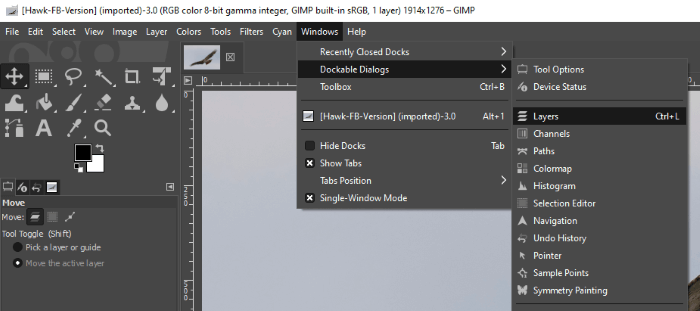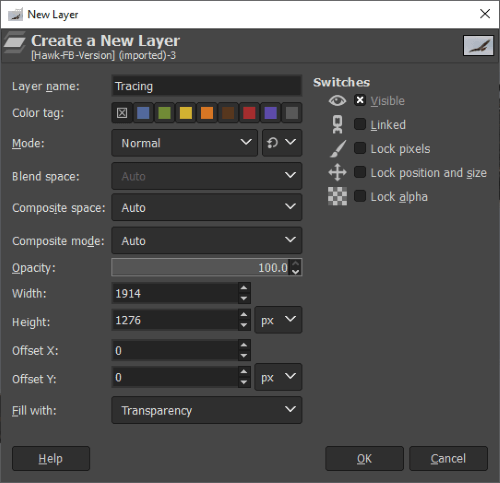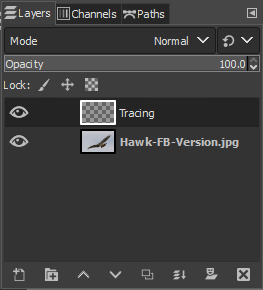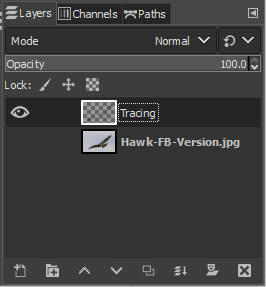How To Trace A Drawing In Gimp
Tracing over elevation of a source image is 1 of the best ways to larn a new drawing style, and you tin can use it for countless other projects as well. Thank you to GIMP's layer-based editing organisation along with its fantabulous castor and selection tools, digital tracing is extremely easy to do.
A Quick Note About Live Trace
Some vector graphics editors accept a feature known as 'alive trace' or something like which automatically traces a bitmap image to create an editable vector epitome of the aforementioned content. GIMP doesn't offer that characteristic, so if that's what you're looking for, bank check out the gratis app Inkscape and its Trace Bitmap tool.
To get started tracing in GIMP, first, you lot'll need to open your source paradigm – no surprises there!

Next, locate the Layers panel, unremarkably located in the bottom correct corner of the GIMP interface. If you can't find it, it may have been closed accidentally.
Bring it dorsum past opening the Windows carte, selecting the Dockable Dialogs submenu, and clicking Layers, or you can utilize the shortcut Ctrl + L (use Command + L if you're using GIMP on a Mac).

Yous'll meet that GIMP has one layer listed in the Layers panel, named using the source image's filename. We'll merely add together a new layer filled with transparency then describe onto the new transparent layer while information technology's still overlaid on the source image.
You tin click the small new layer icon in the bottom left of the Layers console, or you can use the keyboard shortcut Ctrl + Shift + N (use Command + Shift + N on macOS).
You can also employ the same command in the Layer carte, but information technology'southward a good idea to become comfortable working with the keyboard shortcuts.

GIMP will open the Create A New Layer dialog box. It has a huge number of options, but we only need to deal with a few at the moment. Name your layer something descriptive, make sure the Mode: option is set to Normal, and set the Fill up with: option to Transparency.
If you bank check the Layers panel again, y'all'll see at that place is a new entry in the list named Tracing (or whatsoever you named your layer).
Click the thumbnail to make sure the new layer is selected, or you'll stop upwardly tracing onto your source prototype! You'll see a white outline around the epitome thumbnail of the currently selected layer.

Last but definitely not least, it's time to get tracing! GIMP has excellent brush-based tools with lots of customization options and presets, assuasive you to recreate about whatsoever physical drawing or painting medium.
I recommend that you offset out with the Paintbrush if you've never used GIMP to draw before, but you might also want to explore the MyPaint brush.
MyPaint was incorporated into GIMP in version 2.10 and uses an open-source painting engine that'southward much more sophisticated than GIMP's paintbrushes. It's not just for pigment, though, equally information technology has a number of presets for more traditional cartoon and sketching media like pencils and charcoal.
Select the brush you desire to use, and get tracing!
Tip: If yous don't want to draw by paw and you lot only want to trace an outline, you lot can endeavour using a selection tool to outline your object, and then use the Stroke Selection control in the Edit menu to employ a stroke to your selection edges.
Once you lot're finished, all that remains is to hide the source paradigm layer. If you're non quite certain how your traced image looks, yous tin can temporarily hide the source image layer by clicking the small centre-shaped icon next to the appropriate layer in the Layers panel.

(Some editors recommend deleting this layer, simply I retrieve that it'due south always a good idea to go along as much image data as possible in your working file, so hang onto it!)
The icon will disappear and the source image will be subconscious, replaced by the checkerboard pattern that GIMP uses to indicate transparent pixels – unless you traced over the whole canvas, of course!

If you're happy with the results, you tin add some other new layer filled with white or whatever background color you wish, and place it between the tracing layer and your source epitome layer.

You tin can go as detailed as you lot desire, of class! Add as many dissimilar tracing layers as you lot'd like to aid keep your drawing organized.
That'south just about everything there is to know about how to trace an image in GIMP!
Source: https://thegimptutorials.com/how-to-trace/
Posted by: rinknottionged.blogspot.com


0 Response to "How To Trace A Drawing In Gimp"
Post a Comment